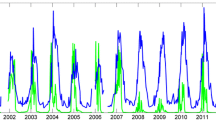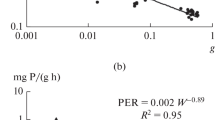Abstract
The respiratory metabolism of the copepod Acartia clausi, the most abundant species of zooplankton in the area investigated (Gulf of Fos, Mediterranean Sea, France) was studied at different temperatures during an annual cycle. Copepods were collected from three different stations: first the intake area, where sea water was pumped into the cooling circuit of a power plant; second, the outlet area of this circuit, where the heated effluents were discharged with an average Δt of 6°C; third, a small protected bay directly influenced by the flow of the heated waters. Seasonal variations in respiration intensity were observed, with a spring maximum. Specimens collected from the heated effluents exhibited comparatively reduced metabolism. Q10 varied with temperature and time of year, suggesting seasonal regulation of metabolism. Except in March, where metabolic curves differed markedly according to the origin of the sample (species from the heated effluents displaying a metabolic curve of the summer type), the principal difference in shape of the respiration-temperature curves appeared in the range of 10° to 14°C, where reduced respiration was observed in specimens from the heated effluents. When A. clausi from external areas were exposed to artificial thermal stress, they displayed a respiratory metabolism pattern similar to that of specimens sampled from the heated effluents. Experiments performed with warm-acclimated copepods revealed respiratory modifications similar to those observed in copepods from the heated effluent. These results are discussed in relation to the thermal conditions prevailing at the investigated site.
Similar content being viewed by others
Littérature citée
Anraku, M.: Influence of the Cape Cod Canal on the hydrography and on the copepods in Buzzards Bay and Cape Cod Bay, Massachusets. II. Respiration and feeding. Limnol. Oceanogr. 9, 195–206 (1964)
Bader, R.G. et D.C. Tabb: An ecological study of south Biscayne Bay in the vicinity of Turkey Point. Prog. Rep. U.S. atom. Energy Commn. (Coral Gables, Fla; Rosenstiel School mar. atmos. Sci., Univ. Miami) 1–81 (1970)
Barnes, H. and M. Barnes: Seasonal changes in the acutely determined oxygen consumption and effect of temperature for three common cirripedes, Balanus balanoides (L.), B. balanus (L.) and Chthamalus stellatus (Poli). J. exp. mar. Biol. Ecol. 4, 36–50 (1969)
Basedow, T.: Über die Auswirkung von Temperatureschocks auf die Temperaturresistenz poikilothermer Wassertiere. Eine Untersuchung zum Problem der thermischen Schockanpassung bei Tieren. Int. Revue ges. Hydrobiol. 54, 765–789 (1969)
Blanc, F. et M. Leveau: Plancton et eutrophie: aire d'épandage rhodanienne et Golfe de Fos (traitement mathématique des données), Thèse Doctorat Science Université Aix-Marseille 1973
Bullock, T.H.: Compensation for temperature in the metabolism and activity of poikilotherms. Biol. Rev. 30, 311–342 (1955)
Carpenter, E.J., B.B. Peck and S.J. Anderson: Survival of copepods passing through a nuclear power station on northeastern Long Island Sound, USA. Mar. Biol. 24, 49–55 (1974)
Conover, R.J.: Oceanography of Long Island Sound, 1952–1954. VI. Biology of Acartia clausi and A. tonsa. Bull. Bingham oceanogr. Coll. 15, 156–223 (1956)
Fry, F.E.J.: Temperature compensation. A. Rev. Physiol. 20, 207–224 (1958)
Gaudy, R.: Constribution à la connaissance du cycle biologique et de la physiologie des copépodes du Golfe de Marseille. 2. Etude du cycle biologique de quelques espèces caractéristiques. Téthys 4, 175–242 (1972)
—: Les varilations saisonnières de la respiration chez quatre espèces de copépodes pélagiques du Golfe de Marseille. Neth. J. Sea Res. 7, 267–279 (1973)
Gauld, D.T. and J.E.G. Raymont: The respiration of some planktonic copepods. II. The effect of temperature. J. mar. biol. Ass. U.K. 48, 49–75 (1953)
González, J.G.: Critical thermal maxima and upper lethal temperatures for the calanoid copepods Acartia tonsa and A. clausi. Mar. Biol. 27, 219–223 (1974)
Halcrow, K.: Acclimation to temperature in the marine copepod Calanus finmarchicus (Gunner). Limnol. Oceanogr. 8, 1–8 (1963)
Heinle, D.: Temperature and zooplankton. Chesapeake Sci. 10, 186–209 (1969)
Markowski, S.: The cooling water of power stations: a new factor in the environment of marine and freshwater invertebrates. J. Anim. Ecol. 28, 243–258 (1959)
—: Observations on the response of some benthonic organisms to power station cooling water. J. Anim. Ecol. 29, 349–357 (1960)
Mayzaud, P.: Etude du métabolisme de quelques espèces du zooplancton et ses conséquences biologiques: respiration et excrétion azotée, Thèse Doctorat 3ème cycle, Université Paris VI 1971
Newell, R.C. and V.I. Pye: Seasonal changes in the effect of temperature on the oxygen consumption of the winkle Littorina littorea (L.) and the mussel Mytilus edulis L. Comp. Biochem. Physiol. 34, 367–383 (1970)
Nival, P., G. Malara, R. Charra, I. Palazzoli et S. Nival: Etude de la respiration et de l'excrétion de quelques copépodes planctoniques (Crustacea) dans la zone de remontée d'eau profonde des côtes marocaines. J. exp. mar. Biol. Ecol. 15, 231–260 (1974)
Pattée, E.: Sténothermie et eurythermie. Les invertébrés d'eau douce et la variation journalière de température. Annals Limnol. 1, 281–434 (1965)
Rao, K.P. and T.H. Bullock: Q10 as a function of size and habitat temperature in poikilotherms. Am. Nat. 88, 33–49 (1954)
Reeve, M.R. and E. Cosper: The acute thermal effects of heated effluents on the copepod Acartia tonsa from a sub-tropical bay and some problems of assessment. In: F.A.O. Technical Conference on marine pollution and its effects on living resources and fishing, pp 1–5 Rome: 1970
Schlieper, C.: Versuch einer physiologischen Analyse der besonderen Eigenschaften einiger eurythermer Wassertiere. Biol. Zbl. 71, 449–461 (1952)
—: Genetic and nongenetic cellular resistance adaptation in marine invertebrates. Helgoländer wiss. Meeresunters. 14, 482–502 (1966)
Sylva, D. de: Theoretical considerations of the effects of heated effluents on marine fishes. In: Biological aspects of thermal pollution, pp 229–293. Ed. by P.A. Krenkel and F.L. Parker. Vanderbilt: Vanderbilt University Press 1969
Vernberg, W.B.: Metabolic-environmental interaction in marine plankton. Proc. Eur. mar. Biol. Symp. 5, 189–196 (1972). (Padova: Piccin Editore)
Author information
Authors and Affiliations
Additional information
Communicated by J.M. Pérès, Marseille
Ces recherches ont été effectuées dans le cadre d'un contrat de recherche financé par l'E.D.F. (Electricité de France) pour l'année 1975.
Rights and permissions
About this article
Cite this article
Gaudy, R. Etude des modifications du métabolisme respiratoire de populations d'Acartia clausi (Crustacea: Copepoda) après passage dans le circuit de refroidissement d'une centrale thermo-électrique. Mar. Biol. 39, 179–190 (1977). https://doi.org/10.1007/BF00387003
Accepted:
Issue Date:
DOI: https://doi.org/10.1007/BF00387003




